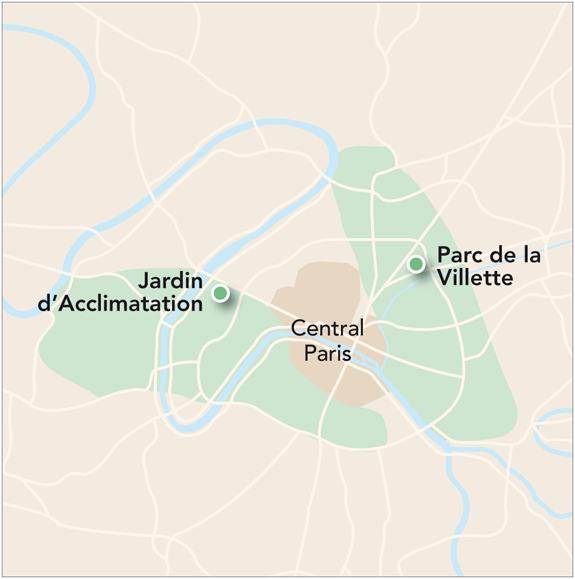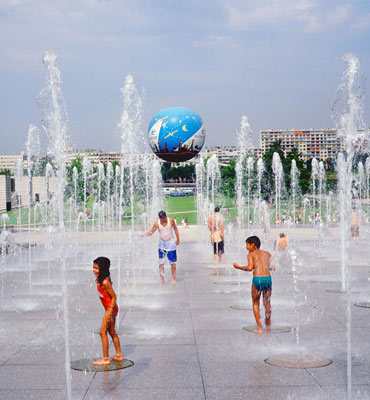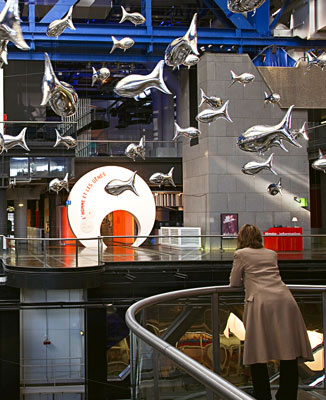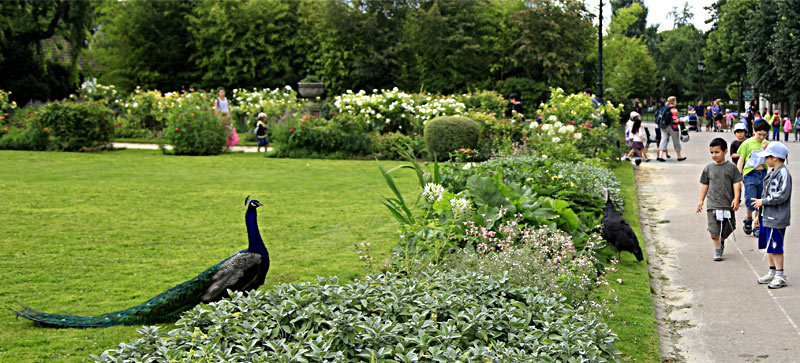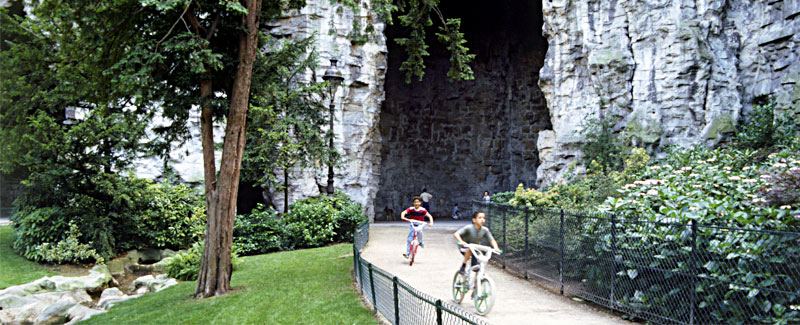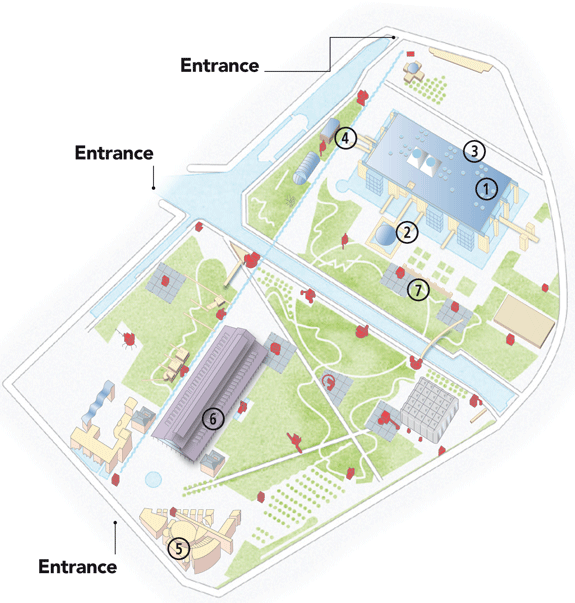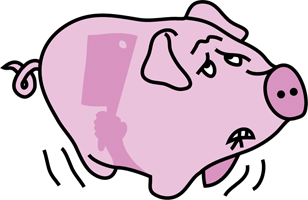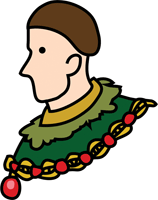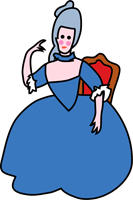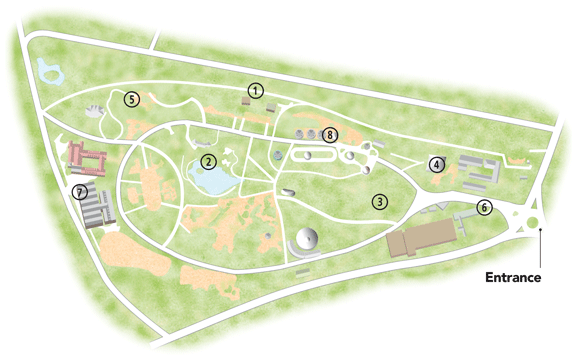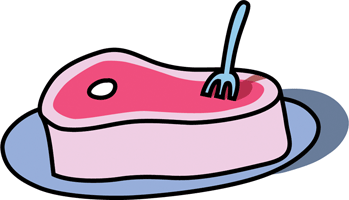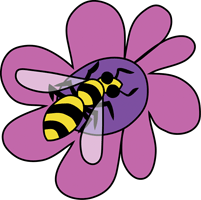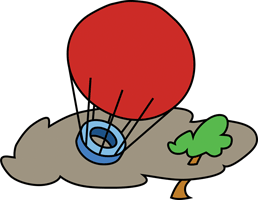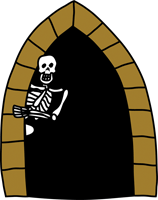< Beyond the City Centre
Parc de la Villette and Around
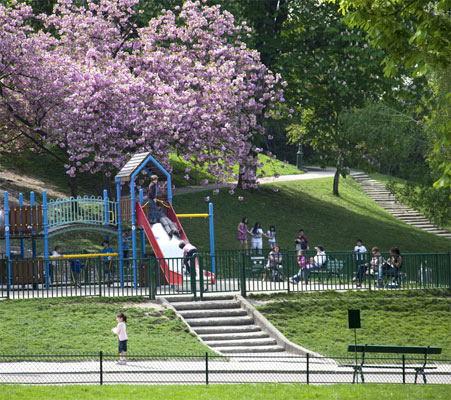
Children at the slides in Parc des Buttes-Chaumont
Eastern Paris has a good mix of indoor and outdoor activities off the main tourist track. The creatively designed Parc de la Villette houses a fantastic science museum, and for history buffs there is a fascinating cemetery, Cimetière du Père Lachaise. The Parc des Buttes-Chaumont is the most romantic park in the city, with a craggy cliff that offers splendid views, while the Bois de Vincennes has a castle with a giant keep, lakes and lots of space. For something different, try the modern Parc de Bercy. On a sunny day, explore the canals de l’Ourcq or St-Martin, and picnic on the towpath, or in the parks.
1. Parc de la Villette
2. Cimetière du Père Lachaise
3. Bois de Vincennes
4. Parc de Bercy
5. Marché aux Puces de St-Ouen
6. Basilique St-Denis
7. Stade de France
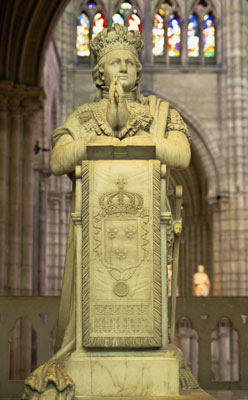
Statue of Louis XVI, Basilique St-Denis
1. Parc de la Villette
Museums, themed gardens and canal boats
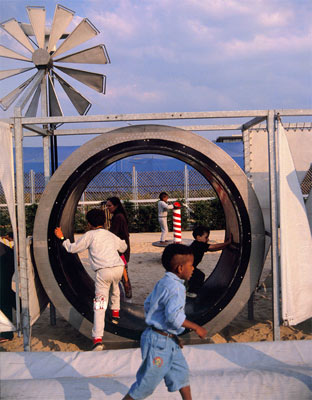
Children playing in Parc de la Villette
In the northeastern corner of Paris, the old slaughterhouses and livestock market have been transformed into a wonderfully wacky park that runs along Canal de l’Ourcq. Full of playgrounds for kids, the complex also houses a concert hall, music centre and exhibition pavilion. The main attraction for families is the Cité des Sciences, Europe’s biggest science museum – it houses the interactive Cité des Enfants, a ground-breaking zone just for children.
Key Features
1. Cité des Sciences et de l’Industrie This futuristic science museum excites children with dazzling hands-on displays. Fly over the surface of Mars in the Planetarium, discover the wonders of the world, or travel through the human body in the Explora exhibit.
2. La Géode The giant hemispherical screen makes 3D movie-watching a truly grand experience.
3. La Cité des Enfants This thematic museum is the place for children aged 2–12 to be TV presenters, weather forecasters, or robot designers.
4. La Cinaxe Experience each moment of an action film via virtual-reality technology in this tilting movie theatre.
5. Cité de la Musique This white, streamlined complex includes a museum with a vast collection covering the history of music since the Renaissance.
6. Grande Halle Once a cattle market, when La Villette was a huge abattoir, it now hosts temporary exhibitions.
7. L’Argonaut Discover marine life through the radars screens and periscopes of this 1930s submarine.

Left L’Argonaut Middle La Géode Right La Cité des Enfants
Kids’ Corner
Things to do…
-
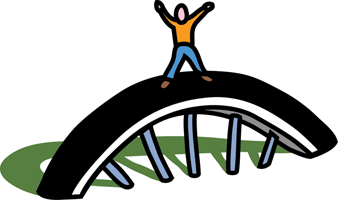
Gaze in amazement at a giant bicycle half-sunk into the ground across the moat from L’Argonaute.
-
Shoot down the slide from the mouth of a giant metal dragon in the Jardin du Dragon.
-
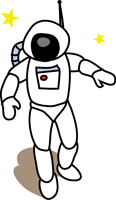
Find out how astronauts are sent into space in the Cité des Sciences.
For the chop
Be glad that you are not a cow or a pig, as La Villette was once the city’s slaughterhouse where millions met their deaths.
Movie brothers
Two brothers, Auguste and Louis Lumière, invented cinema. They made 10 short films and showed them to an audience in the basement of the Grand Café on Boulevard des Capucines in 1895. The brothers were not very impressed with their invention and gave it up soon afterwards. Watch a 3D film in the theatre, La Géode. You will see that cinema has come a long way since then.
2. Cimetière du Père Lachaise
Dead famous
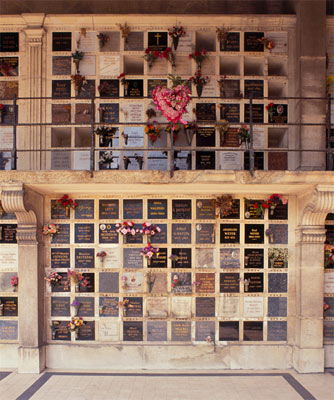
The Columbarium in the Cimetière du Père Lachaise
Far from being grim and spooky, Paris’s cemeteries are full of bizarre and fascinating monuments that make them well worth a visit.
The tombs here read like a roll call of famous people, among them singers Edith Piaf and Jim Morrison, and playwright Oscar Wilde, although the first person to be buried in Père Lachaise, in 1804, was Adélaïde Paillard-Villeneuve, who was just 5 years old. Many tombs have life-size sculptures of those who lie in them and are works of art in themselves.
The 19th-century Columbarium, or “dovecot”, houses the funerary urns of more celebrities within its memorial-covered compartments. The Mur des Fédérés, in the south-eastern corner of the cemetery, is the wall against which supporters of the Paris Commune, called fédérés, were executed by government troops in 1871.
Kids’ Corner
Look out for…

1. Edith Piaf’s tomb. She was a famous singer and is buried in Père Lachaise. What does her name mean?
2. The escalator at Métro Père Lachaise. It was the first one in Paris to start rolling in 1909.
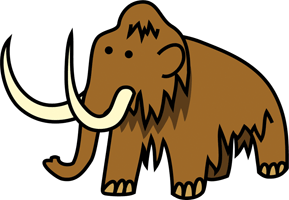
3. Mammoths. Teeth of prehistoric mammoths were found in the Parc de Belleville, located between Parc des Buttes-Chaumont, and Cimetière du Père Lachaise.
Gory gibbet
The grizzly gibbet of Montfauchon once stood on the Buttes-Chaumont where bodies of criminals would swing until they disintegrated or were eaten by rats.
3. Bois de Vincennes
Butterflies, lions and fish
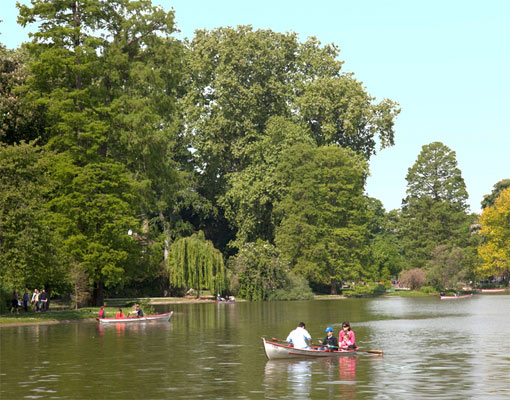
Rowing on the lake in the Bois des Vincennes
To the southeast of the city centre lies the vast parkland of the Bois de Vincennes. Its most dramatic feature is the Château de Vincennes, which was a royal residence until Versailles was built in the 17th century. On a sunny day, picnic in the park, once a royal hunting ground where St Louis used to administer justice under an oak tree. The château has a lovely flower garden, Le Parc Floral de Paris, where there is an excellent playground and lots of activities for the summer, such as electric cars, train rides and a mini-golf course.
There is also a tropical garden and a city farm, La Ferme de Paris, as well as puppet shows and pony rides. Amidst its greenery are four lakes, including a boating lake. The big attraction from Palm Sunday to the end of May is the largest funfair in France, the Fête du Trône.
Kids’ Corner
Look out for…
The Château de Vincennes. It has Europe’s tallest keep at 52 m (170 ft).
Boiling bones
In 1422, the English king Henry V died a painful death from dysentery in the Château de Vincennes. His body was boiled up in the kitchen to preserve it for the long journey back to London.
4. Parc de Bercy
A skater’s heaven
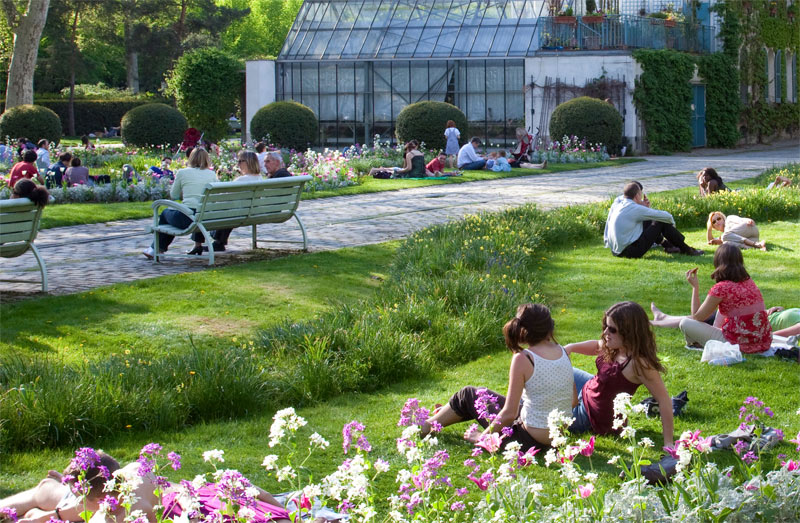
Lush green lawns of the Parc de Bercy on a sunny day
This park was once the wine storehouse of Paris, and many of the pathways retain the rails of the trains that once brought barrels of wine from river boats to the warehouses. There are fountains and statues and plenty of ducks to feed, and the park has a small skating rink. The area of the park named for the late Israeli Prime Minister Yitzak Rabin is a lovely spot dedicated to peace. Rollerbladers should take a turn across the Seine on the Passerelle Simone de Beauvoir bridge near Bercy Village, a 20-minute walk away on the Quai de Bercy. Bercy Village is a good stop for a drink. Several wine warehouses have been converted into shops and cafés.
Kids’ Corner
Look out for…
21 children of the world. These statues in Parc de Bercy form a monument to children’s rights at the beginning of the 21st century. Guess where each one comes from.

5. Marché aux Puces de St-Ouen
Treasure hunting, mussels and bargains galore
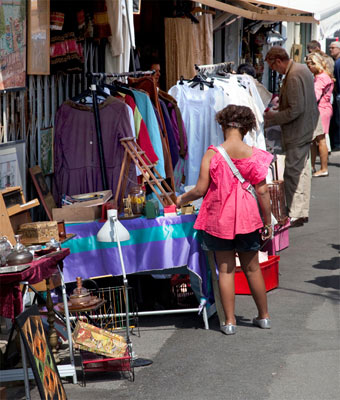
Shoppers in the busy Marché aux Puces de St-Ouen
The biggest flea market in Europe is at the top end of the 18th arrondissement under the Périphérique, the dual-carriageway ring road. The market began in the 1870s when the city’s rag-and-bone men resettled outside the city limits to avoid paying taxes, began to spread their wares on the ground on a Sunday morning. Today, it is an Aladdin’s cave of memorabilia with 3,000 stalls arranged in 15 different markets. On a sunny day, concentrate on the nicest and most retro flea markets – Serpette, Paul Bert and Vernaison – which sell silverware, antiques and second-hand toys.
6. Basilique St-Denis
Headless saints and royal bones
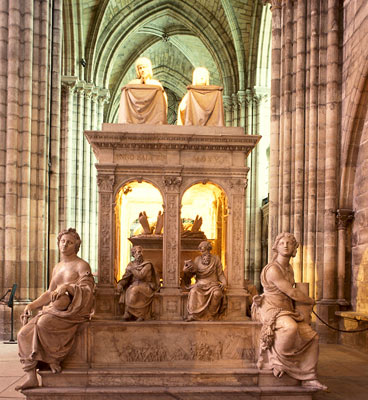
Tombs of Louis XII and Anne of Brittany, Basilique St-Denis
After St Denis, the first bishop of Paris, had his head chopped off by the Romans in AD 250, he picked it up and walked for about an hour before handing it to a woman and dropping down dead. Today, a basilica stands on the spot where he was buried. The abbey of St-Denis, the first in the world to be built in the Gothic style, was a political powerhouse in the Middle Ages and an important place of pilgrimage. In the 7th century King Dagobert who, according to the revolutionary ditty Le Bon Roi Dagobert, wore his trousers back to front, decided that he too would be buried here. It set a trend and nearly all the kings and queens of France followed him into the vaults. During the Revolution, the royal tombs were opened and the bodies dumped in two large pits. Some of the corpses, particularly Henri IV’s, were amazingly well preserved. The graves were reopened in 1817, but the bones were all mixed up and it was impossible to identify any of the royals individually. The remains were placed in an ossuary in the cathedral crypt behind two marble plates inscribed with the names of the kings and queens and their children.
Kids’ Corner
Royal remains
In 1815, the remains of Louis XVI and Marie Antoinette were exhumed from a mass grave in Square Louis XVI, not far from Place de la Madeleine. They are now in the chapel of St-Denis.
The lost Dauphin
After the execution of his father, 10-year old Louis XVII was dragged off and locked up in Paris’s Temple prison. Some stories say he died there in 1795, while others say an unknown boy replaced him. A watchmaker, a naturalist and even a Native American missionary all later claimed to be Louis XVII. However, when the boy believed to be the prince died in prison, a doctor cut out his heart and preserved it in alcohol. It is now in the crypt at St-Denis. DNA tests showed it is definitely that of a Habsburg family member, like his mother Marie Antoinette. So, far from escaping, Louis XVII did die alone in a prison cell.
7. Stade de France
Home of Les Bleus
Built for the 1998 football World Cup, the French national stadium is the fifth-largest in Europe and is home to the French football and rugby teams. Stand on the edge of the pitch where the home team won the World Cup, visit the changing rooms and re-live some of the great moments in sporting history in the museum.
Nearly one billion seeds were sown to produce the first pitch, on which France defeated Brazil to win its first World Cup in 1998. The final of the Coupe de France is played here and the stadium is also used for other sporting events and music concerts. From December to January, the stadium is transformed into a winter paradise with activities such as snowboarding, skating, ice-climbing, snowman-building and sledging.
Kids’ Corner
Do you know…
-
When did football arrive in France?
-
What is the name of Paris’s football team?
-
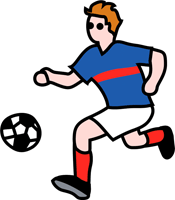
The French national football team is known as Les Bleus, or the Blues. What are the colours worn by the team?
-
Who scored the winning goals in the World Cup in 1998?
< Beyond the City Centre
Jardin d’Acclimatation and Around
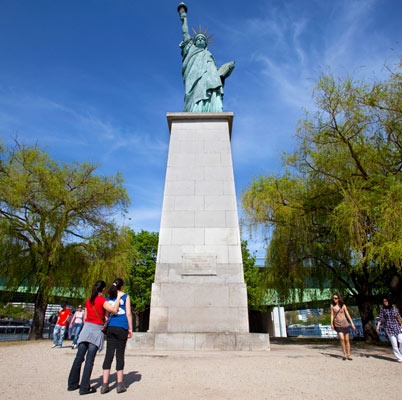
The Seine-side Statue of Liberty facing west, towards the original in New York
Amusement parks took off in Europe at the end of the 19th century. The Jardin d’Acclimatation, in the Bois de Boulogne, was inaugurated by Napoleon III in 1860, and is the main children’s attraction on the western side of Paris, but there is an interesting mix of other things in the area, old and new. A good way to get around here is by using the Métro, unless you are heading to the Château de Malmaison, which is accessed via RER and bus.
1. Jardin d’Acclimatation
2. Château de Malmaison
3. Parc André Citroën
4. Statue of Liberty
5. Catacombes
6. Parc Montsouris
7. Marché aux Puces de Vanves
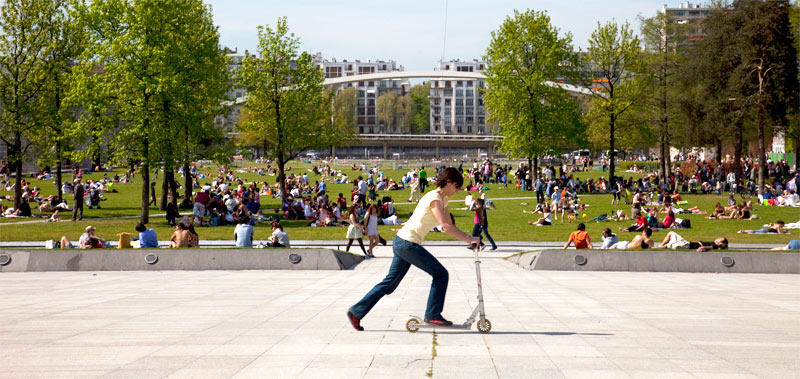
Parc André Citroën, with families soaking up the sun
1. Jardin d’Acclimatation
Puppet shows, an enchanted river and farm animals
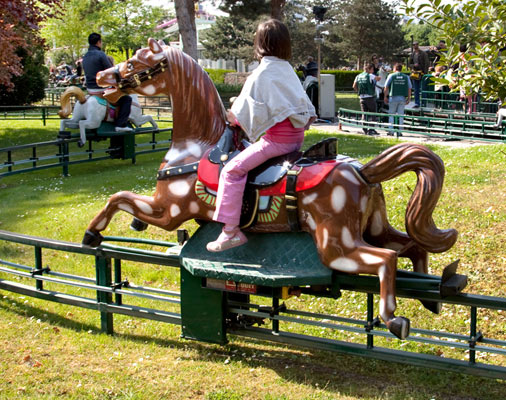
A ride to enjoy in Jardin d’Acclimatation
For generations of kids, the epicentre of the vast and leafy Bois de Boulogne has been the wonderfully retro Jardin d’Acclimatation, a belle époque amusement park opened by Napoleon III in 1860. There is a large selection of activities and rides for all ages, and plenty of water to splash about in on a hot day. If they tire of that, the surrounding parkland is great for cycling, running and exploring, although leave well before sunset as it gets unsavoury after dark.
Key Features
1. La Grande Volière A huge aviary dating from the 1860s, this large enclosure is full of budgerigars, pheasants, partridges and parrots.
2. Gate to Heaven This gate opens into Le Jardin de Séoul, a beautiful tranquil garden that was given to the people of Paris by the Korean capital.
3. Rivière Enchantée The “Enchanted River”, which opened in 1927, offers one of the loveliest rides in the park and is perfect for little children.
4. Le Théâtre du Jardin This theatre hosts musical shows aimed at kids on Wednesdays, Saturdays and Sundays at 3:30pm, often based on fables or fairy stories. Timings may vary.
5. La Petite Ferme Full of turkeys, guinea fowl, rabbits, pigs, swans, sheep, goats, donkeys and even Ilamas, this little farm is a great place to be.
6. La Maison de Kiso This wooden Japanese farmhouse was brought from Japan and rebuilt here in 1860.
7. Le Théâtre de Guignol Located in Napoleon III’s Great Stables, this puppet theatre hosts popular shows.
8. Village des Manèges The innumerable roundabouts and rides for all ages are a major attraction here. The vintage carousel is not to be missed.

Left La Petite Ferme Middle Village des Manèges Right Le Théâtre de Guignol
Kids’ Corner
Elephant steaks and rhino cutlets
In September 1870, Prussian forces laid siege to the city of Paris. Food supplies quickly ran out in the exceptionally cold winter. The elephants, camels and rhinos in the city zoos were bought by the best chefs to feed the rich, while the poor resorted to digging up graves and boiling the bones down into gruel.
Buzzing around
The Jardin d’Acclimatation is home to 240,000 bees, which live by the entrance to the farm. Buy their honey in the shop at the exit.
Believe It or not
From 1877 until 1912, Nubians, Bushmen, Zulus and many other indigenous African peoples were “exhibited” in a human zoo in the Jardin d’Acclimatation.
The scent of death
The cross at the Carrefour de La Croix Catelan near the lake in the Bois de Boulogne is in memory of a messenger, Arnould de Catelan. Back in 1306, he was sent by Beatrix de Savoie to deliver her brother Philippe Le Bel a special gift of luxurious perfumes in the hope it would cheer him up after the death of his wife. Unfortunately Arnould was murdered by a greedy courtier who wanted the present for himself – he believed it was a box of jewels. He was sniffed out by the king because he smelt exceptionally good for the Middle Ages, and was duly snuffed out.
2. Château de Malmaison
An emperor’s new house
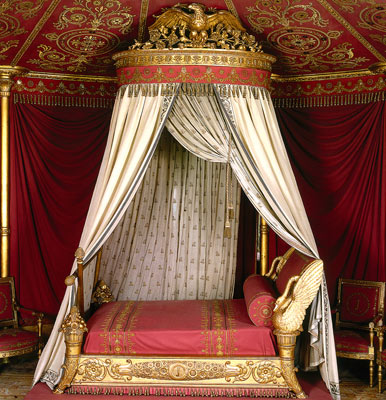
Empress Joséphine’s bed, Musée Château de Malmaison
Napoleon’s first wife, the charming Joséphine de Beauharnais, bought Malmaison in 1799 when Napoleon was campaigning in Egypt. She spent a small fortune transforming the house and the gardens. There was soon a heated orangerie with 300 pineapple plants, perhaps to evoke her native Caribbean island of Martinique, and an exotic garden full of kangaroos, Ilamas, ostriches and zebras.
Napoleon was at his happiest in this small and cosy house and, during the early part of his reign, he took many of his most important decisions here. After their separation, Joséphine continued to live here until her death in 1814. Napoleon came back to spend several days here after his defeat at Waterloo, before departing into exile on the island of St Helena.
There is a fascinating collection of swords in the house. Also on display is the famous painting of Napoleon’s dramatic crossing of the Alps by French painter Jacques Louis David, and the cups from which he drank his coffee.
Kids’ Corner
Find Out More…
1. Why is there a sphinx in Château de Malmaison?
2. Napoleon chose two different animals as his symbols – you can see them on furniture and objects all over Malmaison. What are they?
3. Parc André Citroën
Water, balloons and old cars
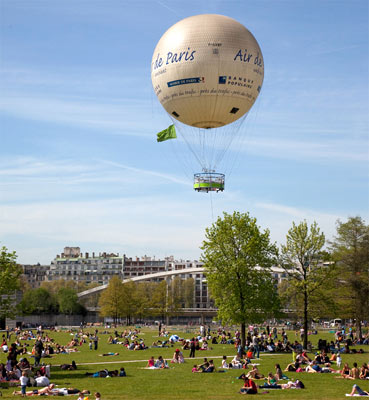
Tethered hot-air balloon, Parc André Citroën
Built on the site once occupied by the Citroën car factory that manufactured the first mass-produced cars in Europe, this park is a wonderful place on a hot day, full of fountains and interesting water features. Kids can run through 120 jets of water that shoot up out of the ground. The big attraction in summer is the tethered hot-air balloon that sails up to 150 m (492 ft) over Paris, offering great views of the city.
There are gardens too: the Jardin Blanc with white flowers and the sunken Jardin Noir, full of dark, almost black foliage. Six other gardens and greenhouses are themed to each represent a different colour, metal, planet, day of the week, type of water and human sense – the Silver Garden, for example, has silvery plants and symbolizes the Moon, Monday, the river and sight. Let the kids try to work out the other five.
Kids’ Corner
Find Out More…
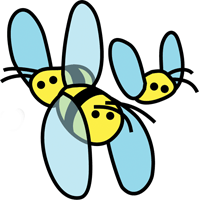
How many jets of water shooting out of the ground does the Parc André Citroën have?
Pollution check
The balloon at the northern end of Parc André Citroën monitors pollution levels. Check its colour – if it is red the air quality is bad, if it is orange then things are not so good and if it is green then you can breathe easy.
A family man
Napoleon was born in Ajaccio in Corsica in 1769, just after France took over the island. He was sent to school at the military academy at Brienne, where he was picked on because he had a strong accent and wore threadbare clothes. When he left the school at the age of 16 he lived on stale bread for a time so that he could save money to send home to his widowed mother and his seven brothers and sisters. A celebrated general by the age of 24, he went on to become emperor. But he never forgot his family, making his brothers kings of the Netherlands, Spain and Westphalia, and one of his sisters Queen of Naples.
4. Statue of Liberty
Not in New York
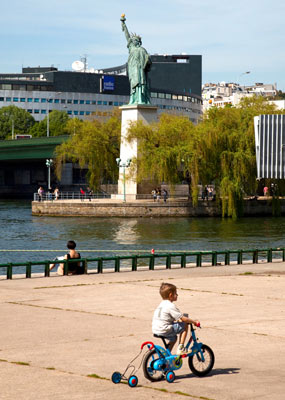
The Statue of Liberty looking out over the Seine
Not only is the French model quite a bit shorter than her sister in New York at 11.5 m (37 ft), she is also a little younger. After creating the giant Statue of Liberty for New York in 1886, the French sculptor Frédèric Bartholdi was commissioned in 1889, by American residents in Paris, to make a copy. She stands on an island in the Seine, gazing westwards and holding a tablet in her left hand. It is engraved with two dates in gold, those of the American and French Revolutions, whereas the New York tablet has only the American date. The Ile aux Cygnes where she stands guard gets its name from an island that is now part of the Champ-de-Mars, where Louis XIV kept his cygnes (swans).
5. Catacombes
Bones, bones and yet more bones
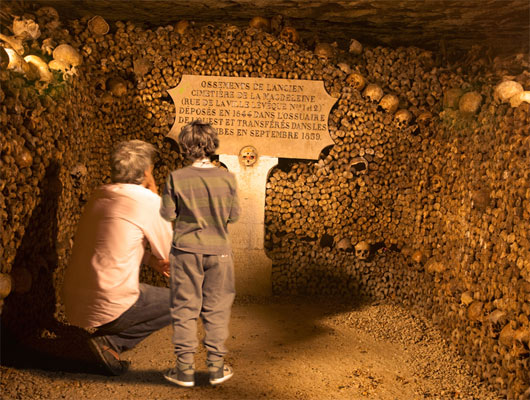
Skulls and bones stacked up in the Catacombes
Take a spooky walk past the bones of six million people stacked up from floor to ceiling. A spiral staircase leads down to a labyrinth of tunnels that run under the city, only 2 km (1.25 miles) of which are on view. Eerie and awesome, it is an unusual experience. Although there is often a queue, out of season the tour becomes a much less busy experience, and all the more atmospheric for that.
The city’s cemeteries were such a health hazard by the end of the 18th century that they were emptied and the bodies reburied in an old quarry here. Among them are the remains of Jean de la Fontaine and Charles Perrault, authors of some of the most famous fairy tales and fables, and the revolutionaries Danton and Robespierre. The Catacombes were opened to the public in 1810 and were originally lit only by flickering candles.
Kids’ Corner
Look out for…
1. Statues of bronze bulls on the gates of Parc Georges Brassens, which used to be a meat market in the mid-19th century.
2. Limestone in the Catacombes. Around 45 million years ago, Paris was covered by a tropical sea and very thick sediment formed on the sea bed creating a layer of limestone. Geologists called this period of history Lutetian after Paris’s Roman name, Lutetia.
Carting bones
The bones from the overcrowded city cemeteries were always moved to the Catacombes at night in carts covered in black veils, accompanied by a procession of chanting priests. It took 30 years to move them all.
Fungi galore
Ordinary button mushrooms that are sold the world over are actually called Champignons de Paris (mushrooms of Paris) and were first grown in the city’s catacombes. Damp and dark, the tunnels provided the perfect home for the little white fungi. They were served up in the city restaurants as delicacies from the time of Louis XIV. When the metro was built, the mushrooms were moved out to caves in the suburbs.
6. Parc Montsouris
Ducks, puppets and pony rides
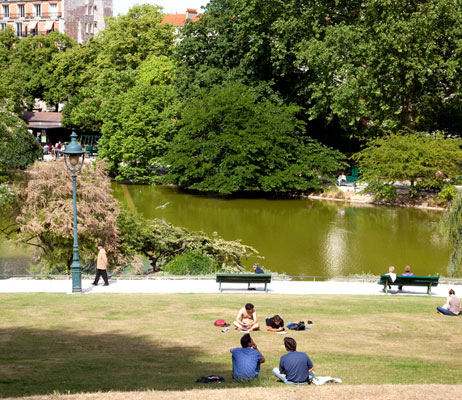
Peaceful lawns by the lakeside, Parc Montsouris
Pretty Parc Montsouris is one of the city’s most charming parks, with lots of quiet corners and beautiful waterfalls. Off the tourist beat, it is a good place to enjoy Paris like a Parisian. There is a lake with plenty of ducks to feed, as well as huge lawns to picnic on, puppet shows and pony rides. Near the Cité-Universitaire, the park has a lively atmosphere and pretty little cobbled streets run off the western side. There were once a lot of mills in this part of Paris, which attracted hordes of mice, hence the name, Mount Mice. Medieval legend says it was here that the giant Isoire was slain by Guillaume d’Aquitaines. Russian Revolutionaries Trotsky and Lenin used to stroll in the park when they lived in Montparnasse.
7. Marché aux Puces de Vanves
Books, buttons and bric-a-brac
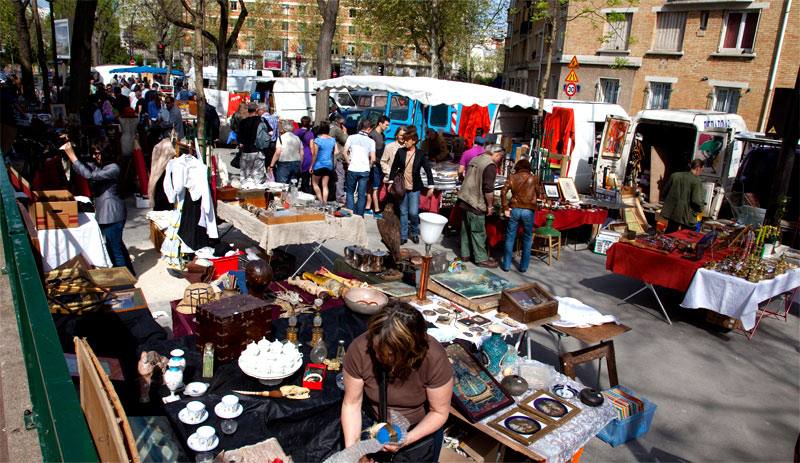
Second-hand furniture, old books and china on sale at the Marché aux Puces de Vanves
Vanves is more old-fashioned and chaotic than the larger flea market at Clignancourt, the
Marché aux Puces St-Ouen, and a better option with children as it is less expensive and more friendly. On a sunny summer morning, stroll under the acacia trees and find interesting souvenirs among the array of buttons, old teapots and every possible knick-knack. There is an interesting second-hand book market, Marché du Livre Ancien et d’Occasion, located in two open-air pavilions that were once used as abattoirs. Also on sale are plenty of classic cartoon books.
